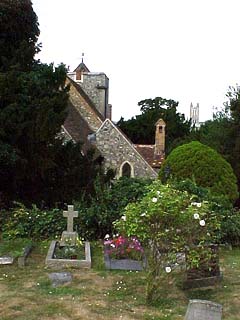|
Saint Martin's Church - description |
||||||||||||||||||||||||||||||||||||||
|
On these pages I have put the full text of a fascinating booklet written just after the last war (around 1947) about Saint Martin's Church. It has no details of author or date of publication. It offers an excellent and detailed account of the church - the oldest church in England still in use. I have added my own photos at relevant points and will add more in time. I have reproduced the leaflet exactly, including nice local touches, with only a few minor editing changes and some updating [in square brackets]. This edition is copyright Stephen Bax 1999. See the usual terms of use.
|
||||||||||||||||||||||||||||||||||||||
|
St. Martin's Church, Canterbury On a gently sloping hill, about a thousand yards due East of the Cathedral, stands the small historic Church known to all English-speaking Christendom as St. Martin's - the Mother Church of our Motherland and of the whole Anglican Communion.
The date of the existing building is a source of never-ending controversy, as it contains many features attributable either to Roman or Saxon architecture. While whatever may be thought of its possible connection with Christian soldiers of the Roman army, or with St. Martin of Tours, there can be no doubt that it was the oratory of Queen Bertha and her chaplain, Bishop Liudhard, as well as the scene of St. Augustine's preaching, and the Baptism of King Ethelbert. In a short sketch of this kind it is impossible to enter into controversial details. The first mention of the Church is the statement by the Venerable Bede, written within 100 years of the death of St. Augustine. It reads: "There was on the East side of the City a Church dedicated in honour of St. Martin; built of old while the Romans were still inhabiting Britain." Bede does not state if it was used for Christian worship in Roman times, or if it was a pagan temple converted to Christian use at a later date. The curtain of history is not again lifted until about the year 580. Ethelbert, the King of Kent, married Bertha, the daughter of Charbert, King of the Franks, who reigned in Paris. Bertha was a Christian and as Ethelbert was a heathen it was stipulated that Bertha be allowed to practice the Christian faith. Bertha was accompanied to England by her chaplain, Bishop Liudhard, and it was to this Church, rebuilt on the Roman ruin and dedicated in honour of St. Martin of Tours, that they came to worship. ^ We now jump to the year 597, to the landing in Kent of St. Augustine and his companions, bringing the Christian message. With the King's permission, it was to St. Martin's they came, and again to quote the words of Bede, "to meet, to sing, to pray, to say mass, to preach, and to baptize." Soon the first fruits of this mission began to appear in the conversion and baptism of the King. We know the ceremony took place on the Feast of Pentecost, June 2nd, 597, but nothing else. Tradition says it was at St. Martin's and in part of the existing font (to be dealt with later), but it is tradition, and at that we must leave it. After the death of St. Augustine the Church relapses into a period of comparative obscurity. It is mentioned in a Saxon charter of 867. It gave its name to two Suffragan "Bishops of St. Martin's" in 1032 and 1052. The Church is a peculiar [which means it is independent of the Archdeacon] and so remains exempt from the jurisdiction of the Archdeacon of Canterbury. By this we are deprived of much valuable information usually found in the Archidiaconal Registers. We do, however, find entries in the years 1511 and 1552. Many items of interest are gathered from numerous wills between the years 1402 and 1598. The list of Rectors is complete from the year 1314. The benefice was united with the parish of St. Paul in 1681. The patronage of the living is in the hands of the Archbishop. The Registers date from 1662, but contain nothing of historical interest, just the bare narration of Baptisms, Marriages and Deaths. ^ |
